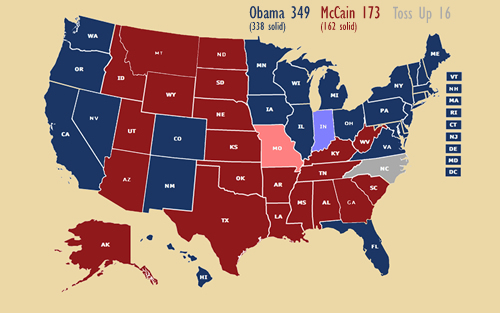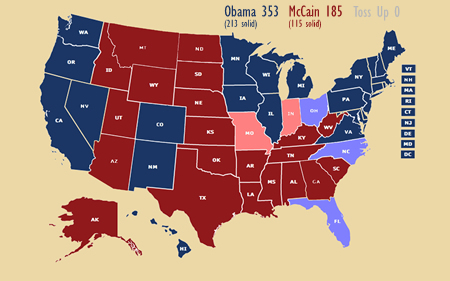Wed 5 Nov, 2008
Morning election update
Comments (1) Filed under: PoliticsTags: Barack Obama, John McCain, Presidential election
While several results remain too close to call this morning, I think it’s time to post an indication of where the races stand at this time.

Presidential race
As shown in the electoral college map above, Obama’s victory was resounding. It was not a landslide in historic terms, but certainly in comparison to recent presidential elections.
As of this writing, Indiana is leaning Obama, and it has been called by some, but not all, of the major networks. Likewise, Missouri is leaning McCain, and has been called by a single network. Indiana has 99% of precincts reporting, while Missouri has 100%; Obama’s lead in Indiana is 0.9%, while McCain’s lead in Missouri is 0.2%.
North Carolina, with 100% of precincts reporting, is still far too close for anyone to call. That state may be counting provisional ballots for days. Note also that Nebraska’s second congressional district, which includes Omaha, is still too close to call (although I believe it’s likely to go to McCain), which means that one of Nebraska’s electoral votes is still up in the air.
How does these results compare with our expectations? Here is the projection which I made yesterday:

As I’m only too willing to point out, with the assistance of contemporary polling and voter models, I was able to call almost every state correctly. The only differences are that Senator Obama appears to have pulled out a close win in Indiana, and we do not yet know how North Carolina will turn out.
Analysis
This race was not historic in at least one important sense. As I’ve mentioned before, the models used by political scientists for forecasting presidential elections were predicting a Democratic win many months ago. These models take into account such factors as the incumbent party, the popularity of the incumbent, and the state of the economy. They tend to be highly accurate at predicting the presidential winner and the eventual vote totals, and they suggest that the individual candidates, their campaigns, and the events of the campaign season matter little to election outcomes.
Thus, political scientists were arguing long ago that the Democratic candidate would be heavily favored to win this election, and by a decent margin. This is exactly what happened.
In other words, Barack Obama didn’t redraw the electoral map. He simply increased the percentage of the vote for the Democratic candidate by a modest amount across the board, compared to recent elections, and this was enough to tip several close states from red to blue. This election didn’t see historic numbers of new voters, or younger voters, or African-American voters. Turnout was high across the board, and there were merely modest increases in young and minority voters.
Race and the election
On race, the recent work in political science which suggests that the Bradley effect is now over seems to have been vindicated. Obama’s leads in the polls generally held up, and he did not experience a decrease in support among white voters relative to the polls.
There are other signs that race was not the significant factor in this election which many observers had predicted. For instance, black voters supported Obama in somewhat greater numbers than they did John Kerry in 2004, but Obama also did better than Kerry among Latinos, Asians, and even whites.
I would argue, however, that the fact that race didn’t play a bigger role in this election is, itself, perhaps the biggest (non-)story of the election. I think the ability of most voters to assess the leading candidates as they would have in any election year, without race being a major factor either way, was not fully appreciated in advance and is a significant indicator of racial progress in the United States.
As someone who still has trouble grasping, not that the nation has elected a black president, but that this is still seen as significant by so many people, I find it heartening the extent to which race doesn’t seem to have mattered in the end.
Of course, for other people this is bad news, because the only conclusion I can draw is that the nation did not deliberately set out to elect a black president, and did not intend this result as atonement for its discriminatory past. A black candidate was elected because he was able to triumph in the Democratic Party’s nomination process, and because the nation was doing poorly enough that the voters were going to opt for change, at least in the sense of switching political parties in the White House, no matter what.
Senate races
The Democrats have increased their majority in the Senate from 51 (when Lieberman is included) to at least 56 seats.
There are four races which remain too close to call—in Alaska, Georgia, Minnesota, and Oregon—which means that there is a theoretical, but unlikely, possibility that the Democrats will control a veto-proof majority in January. In Alaska and Oregon, the Republican incumbents have slim leads, while in Minnesota, the Associated Press called the race for the incumbent and then retracted that call. In Georgia, the incumbent is clearly ahead, but may still not clear the hurdle to avoid a runoff election.
House races
The House of Representatives has been the least interesting part of this election, because the Democrats this term have controlled 232 of 435 seats, and their majority was certain to increase after yesterday. In fact, House Democrats will have at least 252 members, a gain of 20 seats, and there are still five races outstanding.
John McCain On Best Political Blogs » Blog Archive » Morning election update says:
[…] Morning election update While several results remain too close to call this morning, I think it’s time to post an indication of where the races stand at this time. Presidential race As shown in the electoral college map above, Obama’s victory was resounding. It was not a landslide in historic terms, but certainly in comparison to recent presidential elections. As of this writing, Indiana is leaning Obama, and it has been called by some, but not all, of the major networks. Likewise, Missouri is leaning McCain, a […]